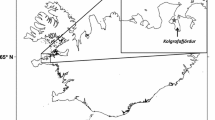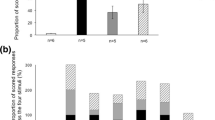Abstract
Although four species of odontocete and four species of baleen whale have been recorded in Prydz Bay, their vocalizations have been rarely investigated. Underwater vocalizations were recorded during March 2017 in Prydz Bay, Antarctica. Bio-duck sounds, downsweeps, inverted “u” shape signals, whistles, pulsed sounds, and broadband clicks were recorded. Bio-duck sounds and downsweeps were associated with Antarctic minke whales (Balaenoptera bonaerensis) based on visual observations. Similarities between inverted “u” shape signals, biphonic calls, and clicks with vocalizations previously described for killer whales (Orcinus orca) lead us believe the presence of Antarctic killer whales. According to sound structures, signal characteristics, and recording location, Antarctic type C killer whales were the most probable candidates to produce these detected calls. These represent the first detection of inverted “u” shape signals in Antarctic waters, and the first report of Antarctic killer whale in Prydz Bay based on passive acoustic monitoring. The co-existence of Antarctic minke and killer whales may imply that minke whales can detect differences between the sounds of mammal-eating and fish-eating killer whales. Our descriptions of these underwater vocalizations contribute to the limited body of information regarding the distribution and acoustic behavior of cetaceans in Prydz Bay.
Similar content being viewed by others
Data Availability Statement
The data that support the findings of this study are available from the corresponding author upon reasonable request.
References
Andriolo A, Reis S S, Amorim T O S, Sucunza F, de Castro F R. 2015. Killer whale (Orcinus orca) whistles from the western South Atlantic Ocean include high frequency signals. Journal of the Acoustical Society of America, 138(3): 1696–1701.
Barrett-Lennard L G, Ford J K B, Heise K A. 1996. The mixed blessing of echolocation: differences in sonar use by fisheating and mammal-eating killer whales. Animal Behaviour, 51(3): 553–565.
Baumann-Pickering S, McDonald M A, Simonis A E, Berga A S, Merkens K P B, Oleson E M, Roch M A, Wiggins S M, Rankin S, Hildebrand J A. 2013. Species-specific beaked whale echolocation signals. Journal of the Acoustical Society of America, 134(3): 2293–2301.
Deecke V B, Ford J K B, Slater P J B. 2005. The vocal behaviour of mammal-eating killer whales: communicating with costly calls. Animal Behaviour, 69(2): 395–405.
Dominello T, Širović A. 2016. Seasonality of Antarctic minke whale (Balaenoptera bonaerensis) calls off the western Antarctic Peninsula. Marine Mammal Science, 32(3): 826–838.
Douglas L A, Dawson S M, Jaquet N. 2005. Click rates and silences of sperm whales at Kaikoura, New Zealand. Journal of the Acoustical Society of America, 118(1): 523–529.
Eskesen I G, Wahlberg M, Simon M, Larsen O E. 2011. Comparison of echolocation clicks from geographically sympatric killer whales and long-finned pilot whales (L). Journal of the Acoustical Society of America, 130(1): 9–12.
Filatova O A, Fedutin I D, Nagaylik M M, Burdin A M, Hoyt E. 2009. Usage of monophonic and biphonic calls by freeranging resident killer whales (Orcinus orca) in Kamchatka, Russian Far East. Acta Ethologica, 12(1): 37–44.
Filatova O A, Ford J K B, Matkin C O, Barrett-Lennard L G, Burdin A M, Hoyt E. 2012. Ultrasonic whistles of killer whales (Orcinus orca) recorded in the North Pacific (L). Journal of the Acoustical Society of America 132(6): 3618–3621.
Filatova O A, Guzeev M A, Fedutin I D, Burdin A M, Hoyt E, Bulletin B. 2013. Dependence of killer whale (Orcinus orca) acoustic signals on the type of activity and social context. Biology Bulletin, 40(9): 790–796.
Filatova O A, Samarra F I P, Barrett-Lennard L G, Miller P J O, Ford J K B, Yurk H, Matlin C O, Hoyt E. 2016. Physical constraints of cultural evolution of dialects in killer whales. Journal of the Acoustical Society of America, 140(5): 3755–3764.
Ford J K B. 1989. Acoustic behaviour of resident killer whales (Orcinus orca) off Vancouver Island, British Columbia. Canadian Journal of Zoology, 67(3): 727–745.
Gassmann M, Henderson E E, Wiggins S M, Roch M A, Hildebrand J A. 2013. Offshore killer whale tracking using multiple hydrophone arrays. Journal of the Acoustical Society of America, 134(5): 3513–3521.
Helble T A, Ierley G R, D’Spain G L, Martin S W. 2015. Automated acoustic localization and call association for vocalizing humpback whales on the navy’s pacific missile range facility. Journal of the Acoustical Society of America, 137(1): 11–21.
Kasamatsu F, Joyce G G. 1995. Current status of Odontocetes in the Antarctic. Antarctic Science, 7(4): 365–379.
Leaper R, Miller C. 2011. Management of Antarctic baleen whales amid past exploitation, current threats and complex marine ecosystems. Antarctic Science, 23(6): 503–529.
Madsen P T, Johnson M, de Soto N A, Zimmer W M X, Tyack P. 2005. Biosonar performance of foraging beaked whales (mesoplodon densirostris). Journal of Experimental Biology, 208(Pt2): 181–194.
Madsen P T, Wahlberg M. 2007. Recording and quantification of ultrasonic echolocation clicks from free-ranging toothed whales. DeepSea Research Part I: Oceanographic Research Papers, 54(8): 1421–1444.
Mellinger D K, Stafford K M, Fox C G. 2004. Seasonal occurrence of sperm whale (Physeter macrocephalus) sounds in the Gulf of Alaska, 1999–2001. Marine Mammal Science, 20(1): 48–62.
Mellinger D K, Stafford K M, Moore S E, Dziak R P, Matsumoto H. 2007. An overview of fixed passive acoustic observation methods for cetacean. Oceanography, 20(4): 36–45.
Miller P J O, Aoki K, Rendell L E, Amano M. 2008. Stereotypical resting behavior of the sperm whale. Current Biology, 18(1): R21–R23.
Møhl B, Wahlberg M, Madsen P T, Heerfordt A, Lund A. 2003. The monopulsed nature of sperm whale clicks. Journal of the Acoustical Society of America, 114(2): 1143–1154.
Munger L M, Wiggins S M, Moore S E, Hildebrand J A. 2008. North Pacific right whale (Eubalaena japonica) seasonal and diel calling patterns from long-term acoustic recordings in the southeastern Bering Sea, 2000–2006. Marine Mammal Science, 24(4): 795–814.
Nemiroff L, Whitehead H. 2009. Structural characteristics of pulsed calls of long-finned pilot whales (Globicephala melas). Bioacoustics, 19(1–2): 67–92.
Oleson E M, Wiggins S M, Hildebrand J A. 2007. Temporal separation of blue whale call types on a southern California feeding ground. Animal Behaviour, 74(4): 881–894.
Pitman R L, Durban J W, Greenfelder M, Guinet C, Jorgensen M, Olson P A, Plana J, Tixier P, Towers J R. 2011. Observations of a distinctive morphotype of killer whale (Orcinus orca), type D, from subantarctic waters. Polar Biology, 34(2): 303–306.
Pitman R L, Ensor P. 2003. Three forms of killer whales (Orcinus orca) in Antarctic waters. Journal of Cetacean Research and Management, 5(2): 131–139.
Rehn N, Filatova O A, Durban J W, Foote A D. 2011. Cross-cultural and cross-ecotype production of a killer whale “excitement” call suggests universality. Naturwissenschaften, 98(1): 1–6.
Rendell L E, Matthews J N, Gill A, Gordon J C D, Macdonald D W. 1999. Quantitative analysis of tonal calls from five odontocete species, examining interspecific and intraspecific variation. Journal of Zoology, 249(4): 403–410.
Reyes Reyes M V, Baumann-Pickering S, Simonis A, Melcón M L, Trickey J, Hildebrand J, Iñíguez M. 2017. High-frequency modulated signals recorded off the Antarctic Peninsula area: are killer whales emitting them? Acoustics Australia, 45(2): 253–260.
Richlen M F, Thomas J A. 2008. Acoustic behavior of Antarctic Killer whales (Orcinus orca) recorded near the ice edge of McMurdo Sound, Antarctica. Aquatic Mammals, 34(4): 448–457.
Risch D, Gales N J, Gedamke J, Kindermann L, Nowacek D P, Read A J, Siebert U, Van Opzeeland L C, Van Parijs S M, Friedlaender A S. 2014. Mysterious bio-duck sound attributed to the Antarctic minke whale (Balaenoptera bonaerensis). Biology Letters, 10(4): 20140175.
Samarra F I P, Deecke V B, Miller P J O. 2016. Low-frequency signals produced by Northeast Atlantic killer whales (Orcinus orca). Journal of the Acoustical Society of America, 139(3): 1149–1157.
Samarra F I P, Deecke V B, Vinding K, Rasmussen M H, Swift R J, Miller P J O. 2010. Killer whales (Orcinus orca) produce ultrasonic whistles. Journal of the Acoustical Society of America, 128(5): 205–210.
Schall E, van Opzeeland I. 2017. Calls produced by ecotype C Killer whales (Orcinus orca) off the Eskström Iceshelf, Antarctica. Aquatic Mammals, 43(2): 117–126.
Simonis A E, Baumann-Pickering S, Oleson E, Melcón L, Gassmann M, Wiggins S M, Hildebrand J A. 2012. High-frequency modulated signals of killer whales (Orcinus orca) in the North Pacific. Journal of the Acoustical Society of America, 131(4): 295–301.
Sirovic A, Hildebrand J A, Wiggins S M, McDonald M A, Moore S E, Thiele D. 2004. Seasonality of blue and fin whale calls and the influence of sea ice in the Western Antarctic Peninsula. Deep Sea Research Part R. Topical Studies in Oceanography, 51(17–19): 2327–2344.
Širović A, Hildebrand J A, Wiggins S M, Thiele D. 2009. Blue and fin whale acoustic presence around Antarctica during 2003 and 2004. Marine Mammal Science, 25(1): 125–136.
Soldevilla M S, Wiggins S M, Hildebrand J A. 2010. Spatial and temporal patterns of Risso’s dolphin echolocation in the Southern California Bight. Journal of the Acoustical Society of America, 127(1): 124–132.
Soto A B, Marsh H, Everingham Y, Smith J N, Parra G J, Noad M. 2014. Discriminating between the vocalizations of Indo-Pacific humpback and Australian snubfin dolphins in Queensland, Australia. Journal of the Acoustical Society of America, 136(2): 930–938.
Van Opzeeland I C, Corkeron P J, Leyssen T, Similä T, Van Parijs S M. 2005. Acoustic behaviour of Norwegian killer whales, Orcinus orca, during carousel and seiner foraging on spring-spawning herring. Aquatic Mammals, 31(1): 110–119.
Van Opzeeland I C. 2010. Acoustic ecology of marine mammals in polar oceans. Reports on Polar and Marine Research, Bremerhaven.
Verfuß U K, Honnef C G, Meding A, Dähne M, Mundry R, Benke H. 2007. Geographical and seasonal variation of harbour porpoise (Phocoena phocoena) presence in the German Baltic Sea revealed by passive acoustic monitoring. Journal of the Marine Biological Association of the United Kingdom, 87(1): 165–176.
Vester H, Hallerberg S, Timme M, Hammerschmidt K. 2017. Vocal repertoire of long-finned pilot whales (Globicephala melas) in northern Norway. Journal of the Acoustical Society of America, 141(6): 4289–4299.
Acknowledgment
The authors thank the crew of the Chinese icebreaker Xue Long for support in data collection.
Author information
Authors and Affiliations
Corresponding author
Additional information
Supported by the National Natural Science Foundation of China (No. 41906170), the Indian Ocean Ninety-east Ridge Ecosystem and Marine Environment Monitoring and Protection (No. DY135-E2-4), the Cooperation of Top Predators Observation in the Southern Ocean (No. QT4519003), and the China-ASEAN Maritime Cooperation Fund
Rights and permissions
About this article
Cite this article
Jiang, Y., Lü, LG., Liu, Z. et al. Identification of Antarctic minke and killer whales with passive acoustic monitoring in Prydz Bay, Antarctica. J. Ocean. Limnol. 40, 485–495 (2022). https://doi.org/10.1007/s00343-021-1017-x
Received:
Accepted:
Published:
Issue Date:
DOI: https://doi.org/10.1007/s00343-021-1017-x




